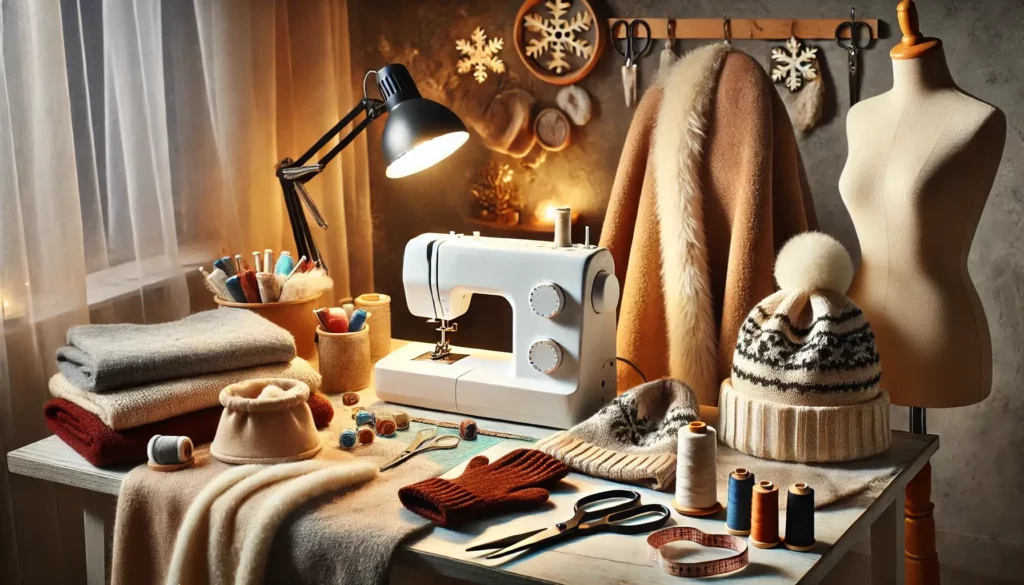How to sew winter accessories (gloves, scarves…)
If you’d like to make some warm accessories this winter, there’s no need to get out your knitting needles and balls of wool!
You can buy warm fabrics (fleece, woollens, etc.) and sew scarves, gloves and mittens.
We’ve selected a few quick and easy sewing projects for you!
Faux fur mittens
If you live in a cold region or simply like to keep your hands warm, then you can sew yourself some faux fur mittens. This is a beginner’s project that can help you get to grips with your machine by practicing simple assemblies and a very quick project to sew.
To make mittens, we follow Mondial Tissus’ free pattern and buy faux fur, fleece for the lining and ribbing for the finishing touches.
Be sure to pin the edge before sewing to prevent the fabric from wrinkling!

Stroller muffs or mitts
Are you a young parent who wants to avoid freezing hands when you take your baby out for a walk in your stroller? Miss Cactus has come up with two patterns, muffs and mitts, so you can go for a walk without freezing to death.
To make this project, you’ll needwaterproof fabric to withstand the elements,fleece to keep your hands warm, interfacing and fleece. The only difficulty lies in sewing the different layers and fitting the snaps.
You’ll need to take your time with these steps.

A fleece or curly fabric bob
Summer or winter, the bob is an all-round hat that goes with every outfit. Our Raclette pattern lets you sew this essential hat for kids, teens and adults.
For a really warm version, you can choose fleece, minky, faux fur or bouclé fabric (also known as teddy or moumoute fabric). The latter has been particularly fashionable in recent years!
The bobbin is quick and easy to sew, but you’ll just have to make sure that the curves are straight and even to get a nice, clean finish!
Sew a scarf quickly
We’re used to hand-knitted scarves, which take several weeks or months to make. If you prefer a quicker alternative that’s just as warm, you can sew yourself a scarf using the warm fabric of your choice. A soft wool, fleece, minky or bouclette fabric…
If you choose a woollen fabric, you can simply cut it to the shape and length you want. Some woollens don’t fray, so they can simply be cut with serrated scissors, without the need for overcasting. If your woollen fabric does fray, you can make a half-centimeter hem along the entire length of your project, pressing it well with a low-temperature iron before stitching.
Prefer fleece or minky fabric? It’s best to assemble it with another fabric, such as simple cotton. If you simply cut into your fleece by overthreading, it risks rolling up on itself. This would give an unsightly effect. So cut two identical shapes from your fleece fabric and cotton. Then join right sides together, leaving a hole of about ten centimetres. Turn your project over completely and close the opening with an invisible seam.
You can follow our home-made tutorial on Youtube if you want to get an idea of the dimensions and images of each step.
You can also add a hood to your scarf, thanks to our latest step-by-step guide, right here.

Sew mittens to ward off winter chill
Less technical than gloves but more elaborate than mittens, mittens are an intermediate project. You can make them if you already know a thing or two about sewing. For this project, you can use fine or thick jersey. This prevents your hands from being too tight.
You can base your design on the Hemmers fabric pattern. And personalize this project as you wish by adding decorative buttons, a little embroidery…

A snood for adults and children
The snood, also known as a choker, is a modern, practical alternative to the classic scarf. It’s easy to put on, keeps you warm and is suitable for adults and children alike. It’s a quick-to-sew project, perfect for using up your fabric scraps while making an essential winter accessory.
To make a snood, simply choose two fabrics you like:
Outdoors: a warm fabric such as fleece, wool or minky.
For the lining: a soft jersey or even a second layer of fleece for very cold days.
It’s a quick and easy project, even if you’re new to sewing. For a detailed step-by-step guide with photos and a video to guide you every step of the way, visit our article dedicated to sewing a snood.
Here you’ll find all our advice on how to get the job done right the first time, including tips for impeccable finishes!
Do you prefer knitting or sewing for your winter accessories?




